Glazed in a homemade Yakitori Sauce, these Japanese Grilled Chicken and Scallion Skewers are hard to resist! You’ll love this simple Yakitori recipe with an easy savory-sweet sauce that you can make ahead. It’s great for grilling outdoors or under the broiler.
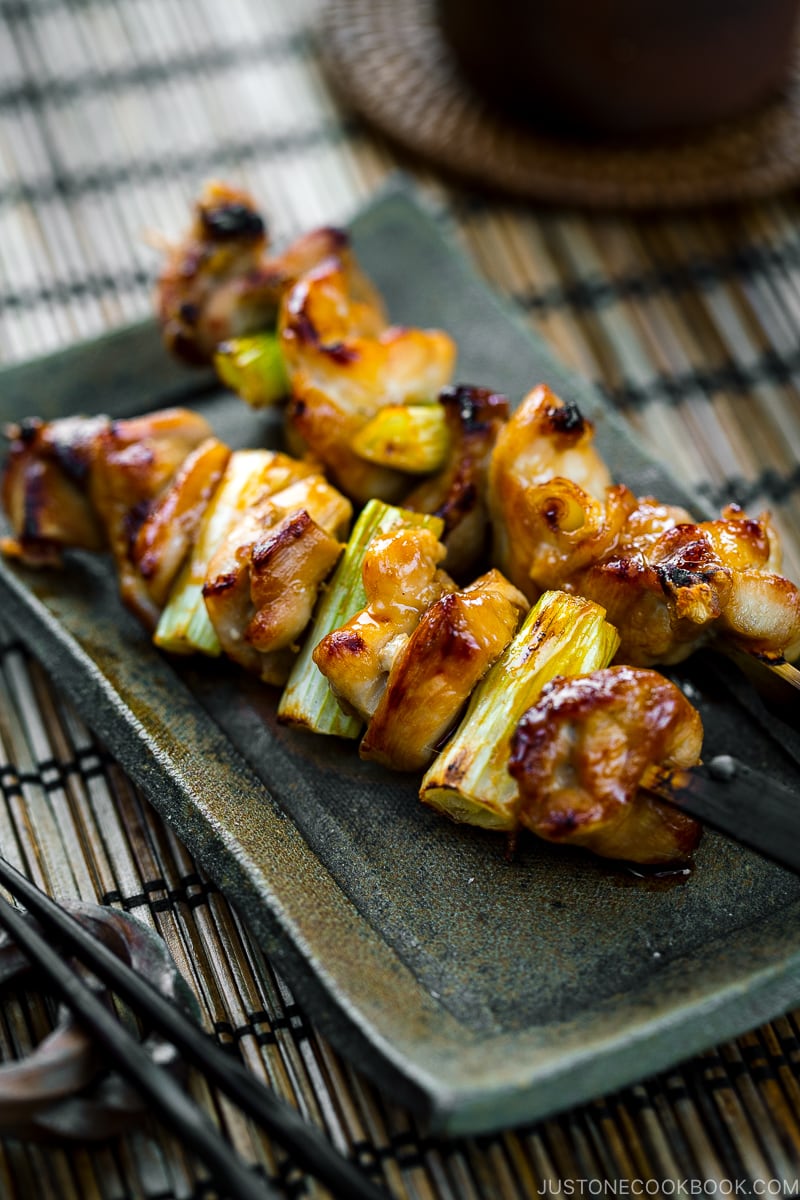
When it comes to chicken on a stick, the Japanese have their own best version known as Yakitori (焼き鳥). The name directly translates to “grilled chicken,” but yakitori represents much more than that—it embodies the essence of good times and joyful hours in Japan.
These chicken skewers are a beloved classic dish often found in izakaya, which are Japanese-style pubs offering a combination of chilled beer, delectable bites, and lively conversations. They are the hallmark offering at specialty restaurants exclusively dedicated to serving Yakitori.
The great news is that making delicious Yakitori at home is easily within anyone’s reach. Allow me to guide you through the process!
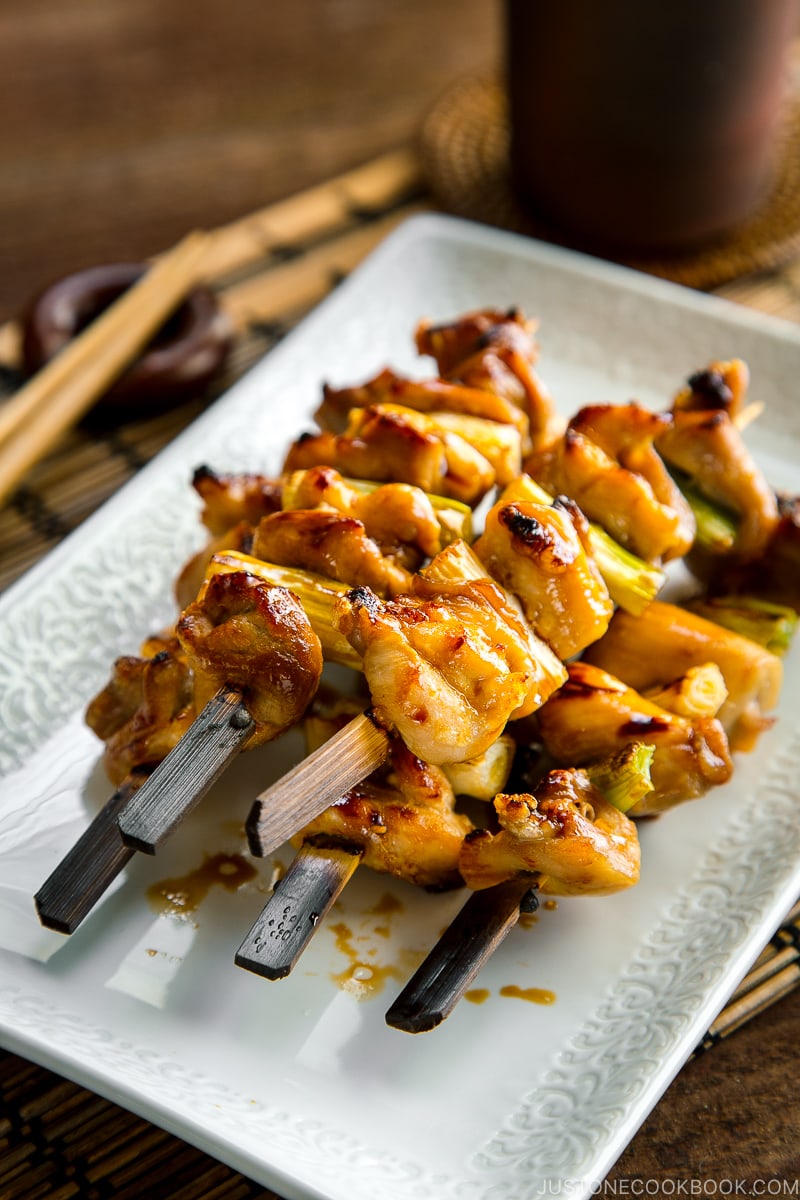
Yakitori in Japan
Just like sushi and tempura, Yakitori in Japan is a serious business. At specialty restaurants, the chefs would go as far as sourcing special breeds of chicken from specific regions known for their unique texture and flavors. Various methods of butchering, skewering, and grilling are applied. And the patrons get to choose from an astonishing selection – from breasts, thighs, cartilage, wings, skins, tenderloin, livers to gizzards.
Here are the examples you’d get on the menu:
- Chicken Thigh (momo, もも)
- Chicken Breast (mune, むね)
- Chicken Thigh & Scallion (negima, ねぎま)
- Chicken Tender (sasami, ささみ)
- Chicken Skin (kawa, 皮)
- Chicken Wings (tebasaki, 手羽先)
- Chicken Tail (bonjiri, ぼんじり)
- Chicken Cartilage (nankotsu, 軟骨)
- Chicken Heart (hatsu, ハツ)
- Chicken Liver (rebā, レバー)
- Chicken Gizzard (sunagimo, 砂肝)
Here, I’m sharing one of the most popular yakitori dishes called Negima Yakitori – chicken thigh and scallion skewer. This is a super easy recipe you’ll love!
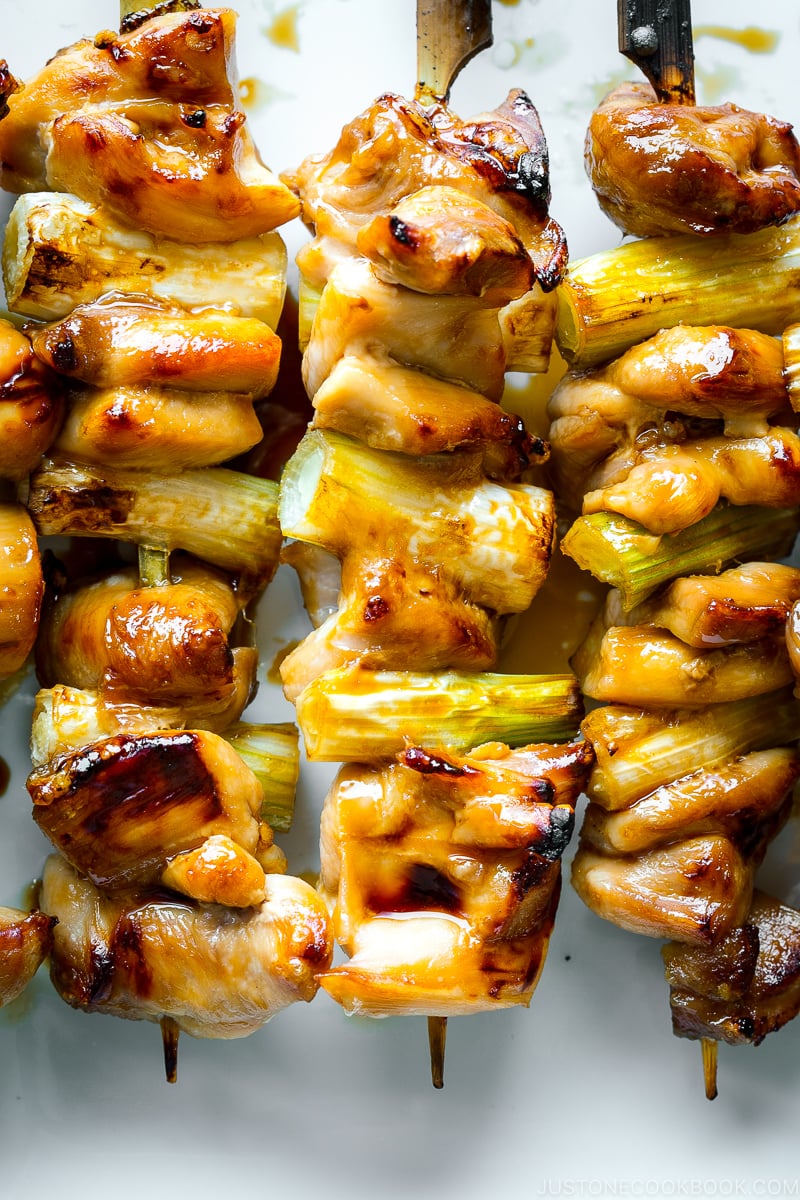
3 Quick Tips for Making Delicious Yakitori
- Use boneless, skinless chicken thighs. They stay juicy and more flavorful compared to breasts.
- Soak the bamboo skewers in water for 30 minutes before threading the ingredients.
- Alternate the chicken with big pieces of scallion on skewers, and make sure they are tightly snugged to each other.
The Seasonings (Shio or Tare)
Most yakitori joints will only offer two simple flavorings: salt (shio) or yakitori sauce (“tare” is pronounced [ta-reh]).
Tare is made of soy sauce, mirin, sake, and sugar. I tested several sauces over the years and we like this version best. It has a good balance between sweet and salty. You can add ginger and other ingredients for the sauce, but in this case, a minimalist is a great approach.
For the purest taste of grilled chicken, you can go without the sauce and simply sprinkle salt before grilling. It’s really amazing how the meat can transform into something so delicious with simple treatments.
Bamboo Skewers for Yakitori
For yakitori, the skewers are usually made from bamboo. We call the typical skewers “teppogushi” (literally means “gun skewer” from its shape). The tapered skewers have a flat tab on one end which makes them easier to turn or hold. They also won’t roll on the grill and allow the chef to grill one side at a time.
You can buy them at Japanese supermarkets or Amazon (regular bamboo skewers will also work).
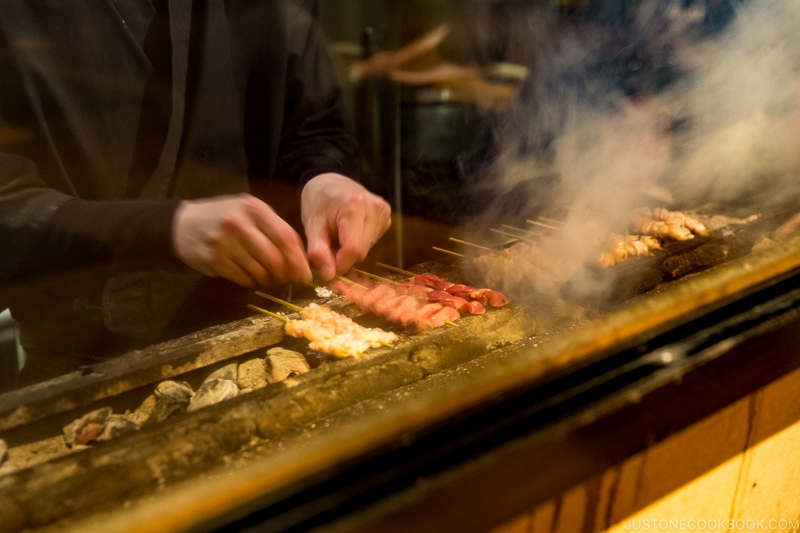
Easy Oven Broil Method
While you may not be able to create the atmosphere of yakitori joints, you won’t go wrong with this easy oven broil method that I share here.
Start by making the tare sauce, then thread the chicken and scallions into skewers. When ready to grill, set the broiler on high at 500ºF, and let the oven does the job. Within 15 minutes, you’d be rewarded with some nicely char-grilled results for the chicken. The recipe works great for the outdoor grill, too.
Itadakimasu!
I love that we can easily recreate this izakaya favorite without any fuss. They are great as a main dish or as an appetizer or as a snack for movie night. There is really nothing not to love about these delicious chicken on the sticks.
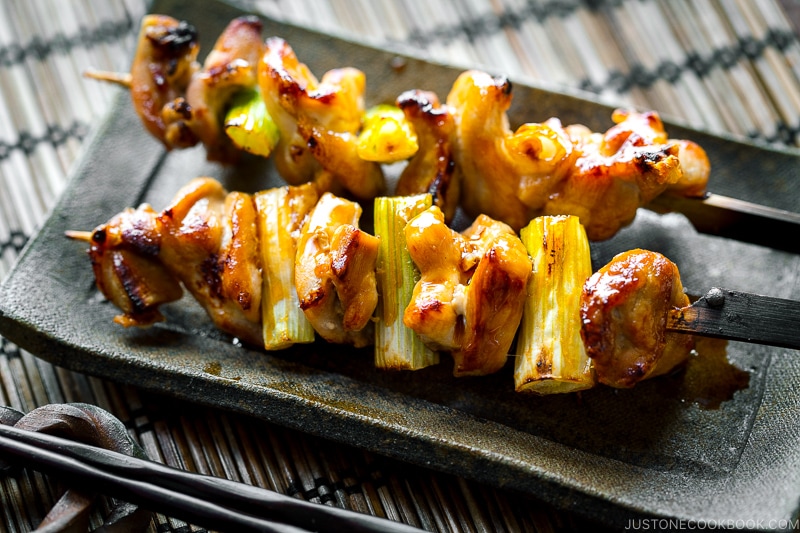
Wish to learn more about Japanese cooking? Sign up for our free newsletter to receive cooking tips & recipe updates! And stay in touch with me on Facebook, Pinterest, YouTube, and Instagram.
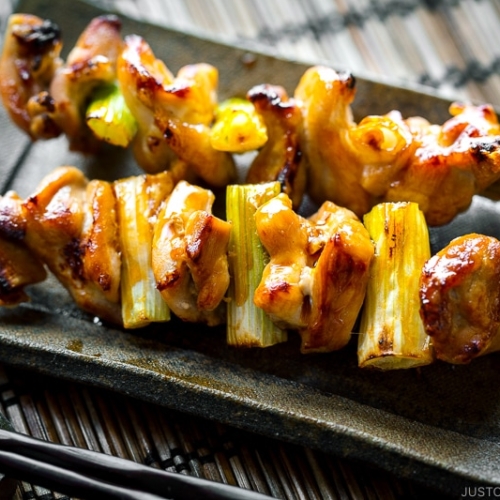
Yakitori (Chicken Skewers) with Homemade Yakitori Sauce
Video
Ingredients
For the Yakitori Sauce (“Tare“):
For the Chicken Skewers
- 9 green onions/scallions
- 1 lb boneless, skinless chicken thighs (at room temperature)
- neutral oil
Instructions
- Gather all the ingredients.

- Soak about 10 to 12 5-inch bamboo skewers in water for 30 minutes.

To Make the Yakitori Sauce (Tare)
- In a small saucepan, add ½ cup soy sauce, ½ cup mirin, ¼ cup sake, ¼ cup water, 2 tsp brown sugar, and the green part of 1 of the 9 green onions/scallions. Bring it to a boil over high heat. Once boiling, reduce the heat to low and simmer, uncovered, until the sauce reduces to one-third of its original volume. It will take about 30 minutes. Let it cool to room temperature before using. The sauce will thicken with a glossy shine as it cools. Tip: You can make the sauce ahead of time. To store, remove the green onion from the sauce and pour into a mason jar. Keep in the refrigerator for up to 2–3 months.

- Reserve one-third of the sauce in a small bowl for final basting, just before serving. To prevent cross-contamination, use this reserved sauce with a clean brush only after the chicken is fully cooked.
To Prepare/Assemble the Yakitori
- Cut the white and light green parts of the remaining green onions/scallions into 1-inch (2.5-cm) pieces.

- Cut 1 lb boneless, skinless chicken thighs into 1-inch (2.5-cm) squares.

- On a flat work surface, fold each slice of chicken in half, insert a bamboo skewer into the chicken at a 45-degree angle, and press down on the skewer to pierce the meat through the center.

- Next, add a piece of scallion perpendicular to the skewer. Continue to alternate chicken slices with pieces of scallion, ending with a piece of chicken. Each 5-inch skewer will hold about 4 chicken slices and 3 scallion pieces.

To Grill/Broil the Yakitori
- Grease the grate of the broiler/wire rack (or oven-safe cooling rack) with neutral oil to keep the chicken from sticking to the grate. Place the skewers on top.

- Set the broiler to High and wait until the heating elements are hot. Then, place the skewers under the broiler. Broil for 6 minutes.

- After 6 minutes, brush the meat on both sides with the Yakitori Sauce. Continue to broil for 3–4 minutes to caramelize the sauce.

To Serve
- Remove the skewers to a serving plate. With a clean brush, baste the top of the chicken skewers with the reserved sauce. Serve and enjoy! Tip: If you accidentally cross-contaminate the reserved sauce (by dipping the same brush you used on the uncooked chicken during cooking), you will have to boil the sauce again.

To Store
- You can keep the leftovers in an airtight container and store in the refrigerator for up to 3 days or in the freezer for up to a month.
Nutrition
Editor’s Note: This post was originally published on Apr 13, 2014. The post has been updated and republished in July 2020.
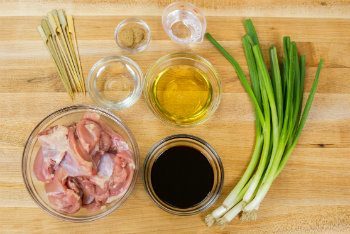
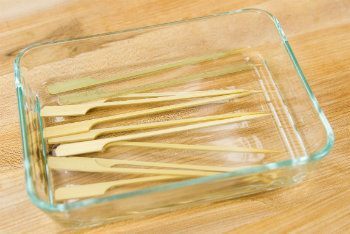

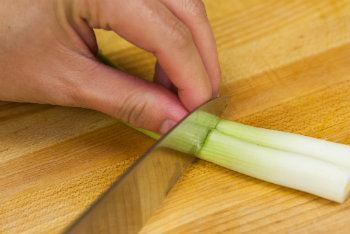


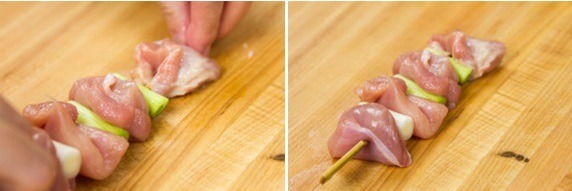
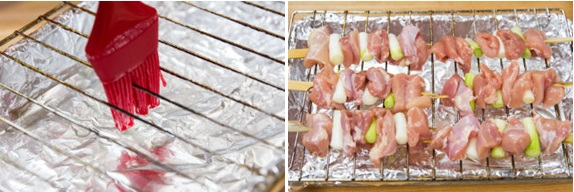
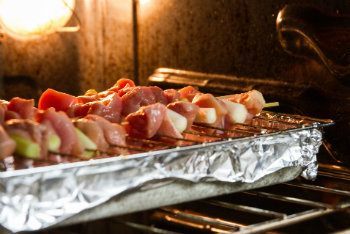
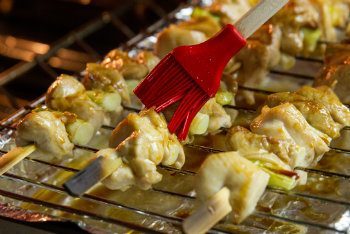
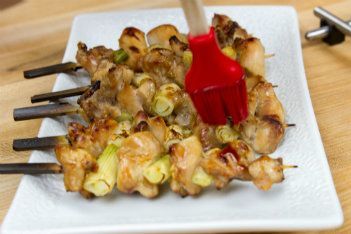











I love your blog! Really authentic recipes!!
I went to Japan about 10 years ago and my husband and I ate in a great yakitori place in Tokyo. It was by Shubuya (sorry for incorrect spelling!). I’m sure that doesn’t narrow down where we ate, but at this one place they had this great mustard (I think?) spicy dipping sauce. Do you have any idea what this could be?
Thanks!
Hi Lisa! I took some time to look into the yakitori shops in Shibuya (you wrote close!) area that serves karashi mustard dipping sauce. I couldn’t figure out your restaurant (so many yakitori shops…) but some places serve karashi mustard by itself (you need to buy Japanese karashi mustard, see below link) or karashi miso sauce. If you remember tasting miso in it, yours might be this one. I’m sorry I’m not too helpful here…
https://www.justonecookbook.com/pantry_items/karashi-mustard/
Thank you so much! I’ll give that a try!
OK, after searching my notes, the name of the place is Akiyoshi Ikebukuro. After looking at pics they have a yellow sauce. I’m pretty sure it was mustard. Anyway, thank you very much and any info would be great.
I just checked, and it looks like they use Neri Karashi.
Picture: http://tabelog.com/en/tokyo/A1305/A130501/13016977/dtlphotolst/1/
Basically you can make it if you can buy Japanese mustard (karashi) powder. You can use Google chrome to translate this Japanese recipe to English.
http://www.sirogohan.com/recipe/karasi/
Hope this helps! 🙂
Thanks so much for your help! I’ll search for this mustard. I guess it’s not a “traditional” yakitori accompaniment- I didn’t see it at any other yakitori places. Thanks again!.
I think I read somewhere that it’s a regional way to enjoy with karashi (for non-tare yakitori). I think it was from Hokkaido and Hakata (Kyushu region). 🙂
So tomorrow is the day I’m finally making these!!! I’ve been wanting to make them for soooo long now… but I have to ask something first:
1. I bought yakitori sauce some time ago, namely this one: http://www.japanesekitchen.co.uk/user/products/large/yakitori_sauce.jpg
Is it ok to use it or should I make one myself? I bought teriyaki sauce once and it tasted nothing like the one you make yourself…
2. Can I use mushrooms instead of scallions? I can’t imagine eating a piece of scallion just like that… 🙂 And grilled mushrooms are delicios <3
Hi Alina! Here are my answers:
1. If you believe that homemade teriyaki sauce was good compared to store bought ones, I highly recommend you to make this yakitori sauce. It’s so good. Many of my readers have tried and they all loved it (and emailed me). So I hope you give it a try one day, if it’s not this time.
2. Sure, definitely! Make sure it’s tightly packed so it won’t fall off from the skewer. The grilled scallion is so sweet and delicious, and the little bitter part (which I almost can’t recognize, but…) adds wonderful flavor to the chicken. The char on the scallion is nice too. Ok, enough about raving grilled scallion. =P Hope you enjoy this recipe!
So I couldn’t wait till tomorrow and made it today… 🙂 It really takes you some time to prepare them! The sauce turned out delicious (I made it according to your recipe). Reminded me a bit of teriyaki chicken which is still my fav Japanese food along with Hijiki Salad 🙂
And you were absolutely right about the scallions,,, 😉 I think I liked them even more than the chicken itself! 🙂
Hi Alina! Haha! I’m so glad to hear the recipe and you tried it with scallion! 😀
Thanks for trying the sauce too! It’s funny – but teriyaki sauce or most of Japanese seasoning is involved sake, soy sauce, mirin, and sugar… Just each recipe has different ratio but the taster is very similar! 🙂
Hi, Nami! How do you recommend we use leftover tare?
Hi C, Thank you very much for trying this recipe! We recommend reheating the leftover tare first and cool it, storing it in the air-tight container in the refrigerator or brush on the Onigiri (rice ball): make rice ball bush the sauce on the rice ball, then grill it. https://www.justonecookbook.com/yaki-onigiri-grilled-rice-ball/
or use it as teriyaki sauce. (This is a very similar sauce) We hope this helps!
Is there a name for that special fixed cooking grate?
I’m interested in getting a large one to do it like the Izakayas.
I don’t think it’s a hibachi, most of the ones i’ve seen are quite small.
I’m thinking if I can find one, then I might make it instead.
Hi Doug! You might be interested in this one. I have a friend who purchased it form this site and he really enjoys it. 🙂
http://korin.com/Grillware_2/konro_grills_3
O’genki, Nami. I love your site and hope to use many recipes. It’s been 17 years since my family lived in Misawa-shi in Aomori prefecture. We love the country, people and foods. In fact, we asked to return to Misawa to live for a total of 7 years. One of my daughters was born there, too. Many HAPPY memories of traveling and camping. Cooking authentic recipes brings back SO many thoughts!! Thank you.
Hi Dori! I’m so happy to hear you enjoyed your life in Japan! I’ve never been to Aomori but I always wanted to visit especially during the big festival. Thank you for following my blog and I hope you enjoy my recipes! 🙂
It happens I’m going to cook chicken thigh tonight and I think yakitori is a healthy way of cooking. I love bbq chicken. Just one problem I don’t have sake. Can I use Chinese wine instead? Thanks. I love your recipes.
Hi Gemma! Sure, you can use Chinese rice wine. As you know, sake and Chinese rice wine taste different, and alcohol should be gone, but the sauce might taste slightly different. I’ve never used Chinese rice wine before, but hope it’ll work! 🙂 Enjoy!!
なみさん、初めまして。私も関東から20代前半で渡米しました。どれも懐かしいメニューばかりで、全部試してみたいです(って何十年かかるんだか?)料理に不安の多い私にとっては、分かりやすいビデオのチュートリアルがあるのは、本当に心強い事です!焼き鳥はアメリカ人の主人の一番の好物なので、なみさんのレシピを早速試してみようと思っています。日本食が好きなお友達にも、「日本人はこういう物を食べているんだよ」と自信を持って勧められるレシピ集だと思いました。本当にありがとうございます!これからのレシピも楽しみにしていますね。
Yokoさん、初めまして!コメント、ありがとうございます!私は二十歳で渡米しました。もう少しで日本とアメリカ、ちょうど半分半分になります。材料さえ揃えば、比較的簡単なレシピだと思うので、是非試してみて下さい。焼き鳥、オーブンじゃなくても外のグリルでもOKですよ。タレはとても美味しいです。気に入ってもらえると嬉しいです。日本食の好きな方が、家で自分で作ってみようと思ってもらえたら嬉しいです。何か質問があったら、いつでもコメント・メール下さいね!
Hello! Do you turn the yakitori over when you apply the tare sauce to both sides or do you leave it on the same side up as before? Thank you! Should sweet sake be used or is regular sake fine?
Hi Jessica! Yes I turn the yakitori when I apply the sauce. So it’ll be…
Cook 6 min.
Pull out and apply the sauce on the cooked part of the chicken.
Flip and raw side is up. Apply the sauce.
Put it back in the oven for 3-4 min.
And remember, not to use this sauce for after cooked. The brush touched the raw chicken, so you won’t be using this sauce at the table. Make sure to take some sauce away first before applying on the chicken. 🙂
I use regular sake (drinking sake like this: https://www.justonecookbook.com/pantry/sake/) for cooking. 🙂
Hope that helps!
These were delicious! Thanks so much for the recipe!
Hi Jake! Thanks so much for trying this recipe and writing the kind comment! I’m so glad to hear you enjoyed the Yakitori. 🙂
Thanks for sharing this recipe! I had no idea that this could be done without an open-face hot plate or grill. I know that I’ll be using my broiler oven this weekend… =)
You’re very welcome, Kimmi! I think people in the U.S. like using an oven for cooking, and I really wanted to make it work for yakiotri so everyone is willing to make yakitori at home! 😉 Hope you enjoy!
I love your recipes which brings fond memories of our trips to Japan. What brand of shoyu do you prefer ?
Hi Hana! I usually use this organic soy sauce from Kikkoman. 🙂
https://www.justonecookbook.com/pantry/soy-sauce/
Hello Nami-san!
I’m brazilian and my wife is a brazilian-born japanese and we absolutely love your site. Since she can’t speak english i aways translate the recipes for her so we can enjoy some delicious food.
We speacially loved your Yaki Udon and Omurice recipes. Thank you VERY much for your awesome job.
We wish you success!!
Hi Fabian! Thank you so much for reading my blog and I’m very happy to hear that you enjoy my recipes. Thank you for your support and kind words! xoxo
Hi Nami
I do not have a broiler. Can I use an oven instead? What temperature should I set the oven at?
Hi Carol! You can use oven, but it may take extra long time until the chicken gets nice char after chicken gets cooked. That could be a reason for dry chicken. Do you have a toaster oven or outdoor bbq grill? That might be a better option than using an “bake” option in oven. However, you may want to give it a try. It might not be too bad. I just never used bake option for making yakitori before, so this is my guess. 🙂
Thank you for your advice, Nami.
My mom loves Yakitori, especially negima, we might make them when we grill outside.
I love kawa and tsukune dipped in raw egg
Hi Asami! Thank you for your comment! Tsukune recipe coming soon… Hope you will like it too! 🙂
Hi Nami,
just wanted to say that we made your Yakitori last week and they were super delicious.
I don’t know if we can link here but a pic: http://imgur.com/OOuAs7e
Hi Asami! Yes I could view your picture! Thank you!!! Your Yakitori looks soooo good! I’m hungry looking at it! 😀 Thank you for sharing the photo!
Made this today on the bbq. So simple and delicious! Thank you Nami!
Hi Po! Yay! We are so happy to hear you enjoyed Yakitori. Thank you very much for trying this recipe and for your kind feedback!
Hi Nami! Just reading today’s recipe just made me feel so nostalgic for the izakaya places in Japan: なつかしい! The sound of the grill, tapping of plates being finished, smell of chracoal and lovely chu-hai drink! Thank you for showing how to do it on the broiler (in Australia, we call it an oven grill). It looks just as delicious! Just like the last comment, I love tsukune! So I am looking forward to that recipe! (^O^)
Hi Maybelle! Aww I’m so glad you enjoyed this post! I feel 懐かしい by writing this post too… remembering how delicious yakitori is in Japan… LOL. Oh yes, with chu-hai サワー! Will share the tsukune recipe pretty soon… Haven’t started to edit photos/video yet. 🙂
Yesterday, I was dreaming about eating good Liver Yakitori! (Not sure why…since the Liver isn’t my favorite.)
I never thought of cooking Yakitori this way. Good idea!
This will make a nice summer party meal along with the Chicken Meatballs. I thought that the Chicken Meatballs were like Tsukune, perhaps.
Thanks for the fun recipe!
Thanks so much Ayako-san! It’s very easy to make, and hope you enjoy this recipe. Tsukune recipe coming soon, too! 😉